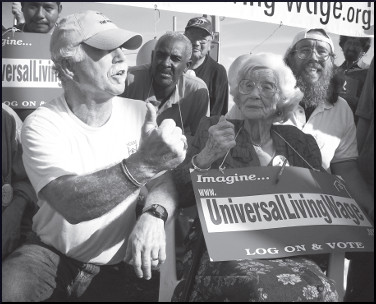
“Bridge” is a loaded word in the homeless community, because for so many people it is the definition of home (as in living beneath a bridge). Sometimes, a communal meal or a church service may take place under a bridge, but the picture is still grim. Several years ago, House the Homeless opened up the meaning of bridge to include the highway overpass, and redefined a bridge as a podium, a pulpit, a stage, a platform, a grandstand. The bridge became the medium through which America learned of the Universal Living Wage.
The economic gap can be bridged, and one of the most practical and sensible ways to begin is through the Universal Living Wage, through recognition that the minimum wage should be tied to local conditions. The dramatic and inspiring story of how Bridge the Economic Gap Day started is all there in Richard R. Troxell’s book, Looking Up at the Bottom Line.
What follows is only a brief summary of a story packed with drama. Someone ought to buy the film rights and make a movie. The picture on this page, taken at one of several Austin action sites, is from the book. Richard is on the left, and the exuberant woman next to him is Eve Adams, who was 100 years old at the time.
For four years, volunteers tirelessly worked to spread the ULW idea and collect endorsements from organizations throughout the country. In 2005, the time seemed right for the first ULW National Day of Action. The chosen date was “Labor Day Plus 1” (which this year falls on September 8—today.) Richard’s goal was to have at least one Bridge Action in every state, so his plan concentrated on width. The Call for Leadership went out. Richard says:
I explained that Bridge the Economic Gap Day would be a great local/national organizing event that would require very little work on their part. We would send our endorsers and participants blank press releases in which they could tout their own organizations and their own local living wage issues. On top of that, we offered to send them the banner for free, and encouraged them to fly their own organizational banner.
Three weeks into the effort, there were commitments from 39 Bridge Captains in 32 states. Donations paid for banners, postage, hardware, and other necessities. The first banner order was optimistic but not splashy. The supplier, J.D. Moore, graciously lowered the price for the second round of banner orders, and lowered it again for the third batch. In the book, Richard discusses his press strategy, and the last-minute need for several hundred dollars for media, and how a more-than-generous donation from his friend and advisor Tom Holmes saved the day. The people who did the phone work each faced unique struggles in their personal lives, but somehow it all got done. The day came when each and every state had at least one Bridge Captain.
Of course, complications emerged, such as the 22,000 refugees from Hurricane Katrina who arrived in Austin, requiring the earnest attention of House the Homeless and every other organization of its kind. Some of those displaced survivors helped to represent the ULW on five of the city’s bridges. Police department guidelines were carefully observed. It was, by the way, 120 degrees in Austin that day. Some participating groups were:
- Saint Edwards Universal Living Wage Warriors
- University of Texas School of Social Worker students
- Americorps VISTA volunteers
- Gray Panthers
- NAACP
- Casa Marienella
The Bridge Actions generated media attention and, more importantly, new allies and connections for House the Homeless and the ULW idea. After that first Bridge the Economic Gap action, the participants gathered at a park where Mobile Loaves and Fishes fed everybody. Richard says:
We shared hot dogs, cold drinks, bridge stories, and our dreams for a kinder, gentler world where economic justice is the norm, not the exception. I closed with a few thoughts and the observation that all across the nation, folks just like us had been on bridges, sharing similar experiences, and the same dream. It felt good.
Bonus Capsulized History of the Universal Living Wage:
Katie McCaskey’s timeline on the House the Homeless News Page
Bonus Atrocity:
“Three Rich Treasury Secretaries Laugh It Up Over Income Inequality”
Source: “Looking Up at the Bottom Line
Image by House the Homeless
Bridge Action
0


